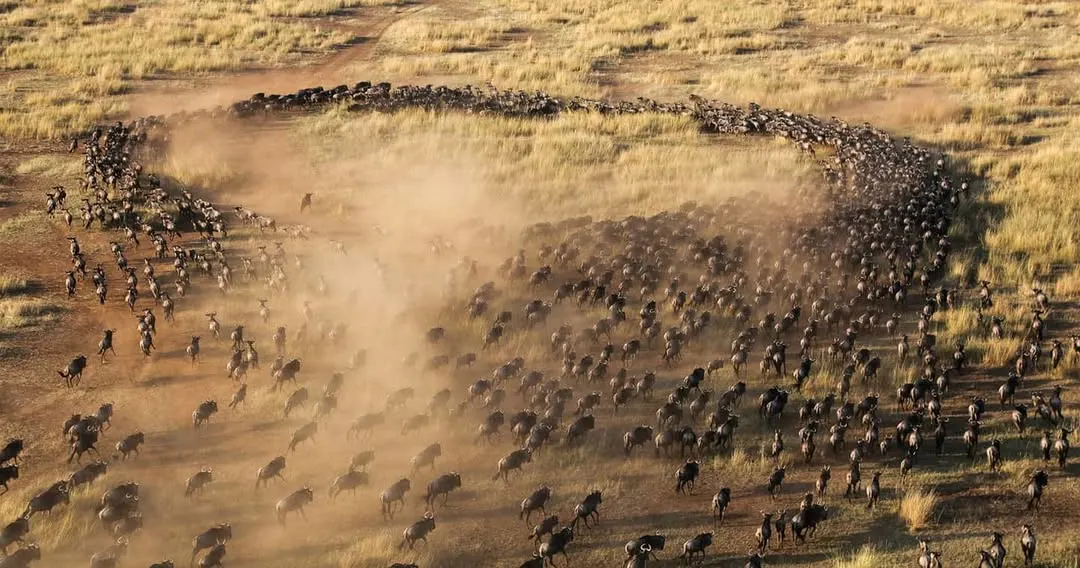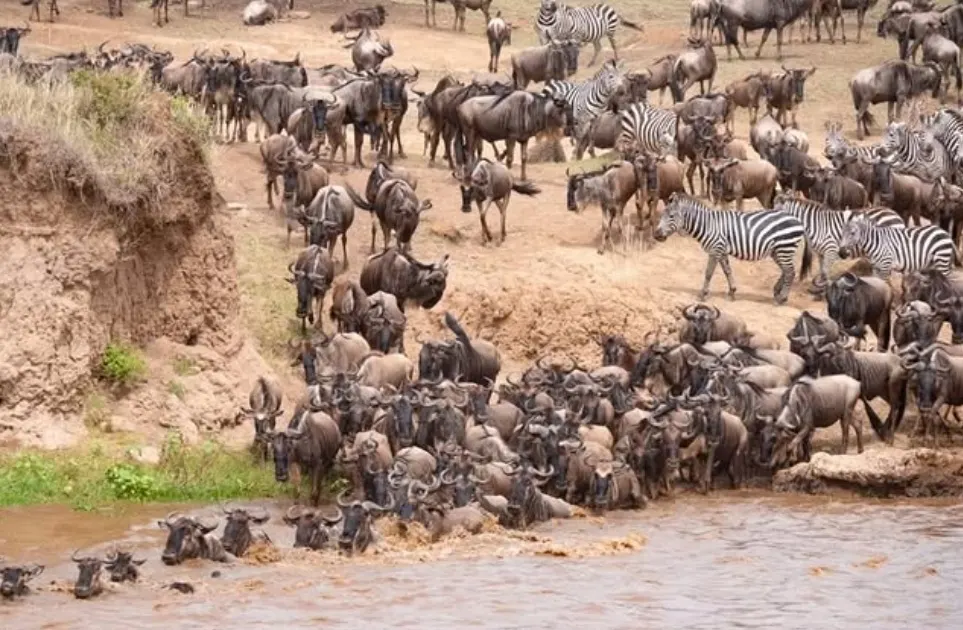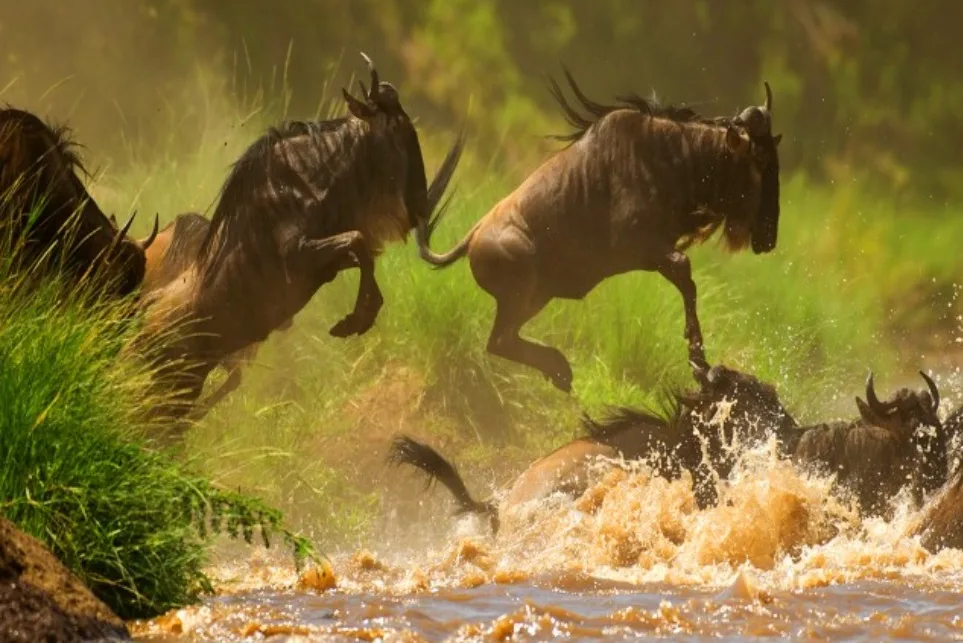Wildebeest Migration 2025




About Wildebeest Migration 2025
The Great Wildebeest Migration is the continuous, year-long movement of over 1.5 million wildebeest, accompanied by hundreds of thousands of zebras and gazelles, across the Serengeti-Mara ecosystem. The 2025 Kenyan chapter of this event will see these massive herds enter the Masai Mara National Reserve in search of fresh grazing lands. This travel planning guide provides practical dates, logistics, and on-the-ground advice for travelers planning to witness this natural spectacle.
This event is a primary attraction for wildlife photographers and safari enthusiasts. Kenya Peaks Adventures plans complete migration safari packages, coordinating expert guides, accommodation, and logistics to place you in the best possible viewing locations.
Dates and Schedule of The 2025 Wildebeest Migration in Kenya
The migration is a natural event governed by rainfall patterns, so exact dates are never guaranteed. The timing below is based on historical data and serves as a reliable forecast for the 2025 season. The main event in the Masai Mara is the crossing of the Mara River.
Predicted 2025 Timeline
- Late June – Early July 2025: The first large herds of wildebeest and zebra are expected to arrive from the Serengeti, entering the southern plains of the Masai Mara.
- July – September 2025: This is the peak season. The herds will be spread across the reserve, and the dramatic Mara River crossings are most likely to occur during this period.
- October 2025: The herds begin their slow return journey south toward the Serengeti as the grazing thins and the rains shift.
- November 2025: By this time, the majority of the migratory herds have typically left the Masai Mara.
Location and Map for the Wildebeest Migration Sighting in Masai Mara NR
The Kenyan stage for the migration is the Masai Mara National Reserve and the surrounding private and community conservancies, such as the Mara Triangle and Mara North Conservancy. The central feature of this event is the Mara River, which the herds must cross to access fresh grass.
The Masai Mara is approximately a 6-hour drive from Nairobi. The more common and efficient way to arrive is by a 45-minute flight from Wilson Airport in Nairobi to one of the Mara's numerous airstrips, such as Keekorok, Ol Kiombo, or Mara Serena.
Park Fees and Safari Booking for Wildebeest Migration Tour 2025
There are no "tickets" to the migration itself. Access requires paying daily park entry fees to the Kenya Wildlife Service (KWS) or the relevant conservancy management. These fees are charged per person, per 24-hour period, with different rates for non-resident adults and children. These fees are typically included in the price of a safari package.
The best way to experience the migration is by booking a safari package that includes a vehicle, a professional driver-guide, and accommodation. Booking well in advance (9-12 months) is necessary, as camps and lodges fill up quickly for the peak season. Our migration safari packages are designed to secure prime lodging and expert guides.
What to Expect on the Ground during the Migration 2025
The atmosphere during the migration is intense and dramatic. The river crossings are the main draw and can attract a large number of safari vehicles. A successful experience requires patience and a knowledgeable guide.
Traveler feedback often highlights the need to manage expectations. You can wait for hours for a crossing to begin, and sometimes the herds turn back without crossing at all. The event itself is a raw display of nature, complete with dust, noise, and the tension of predator-prey dynamics. A good guide is essential for finding a good viewpoint without contributing to overcrowding at the riverbanks.
Do's and Don'ts for Migration Viewing
- Do: Bring and use binoculars for better viewing from a respectful distance.
- Do: Listen to your guide’s instructions at all times. Their priority is your safety and the animals' welfare.
- Do: Be patient. The wildlife operates on its own schedule.
- Don't: Make loud noises or sudden movements near the riverbank, as this can spook the herds.
- Don't: Pressure your guide to drive off-road in the National Reserve or get dangerously close to the animals.
How to Get to the Masai Mara
There are two primary ways to reach the Masai Mara from Nairobi.
- By Air: This is the most efficient method. Scheduled flights depart daily from Wilson Airport in Nairobi to various airstrips within the Mara. The flight takes approximately 45-60 minutes.
- By Road: A road transfer in a 4x4 safari vehicle takes approximately 6-7 hours. This is a more budget-friendly option and allows you to see the Great Rift Valley along the way.
You can find more general transport information in our guide to Getting Around Kenya.
Where to Stay for the Migration in 2025
Location is the most important factor when choosing accommodation. Staying close to the Mara River minimizes travel time each day.
- Luxury Tier: Camps like Governors' Camp or Angama Mara are situated in prime locations with direct views of the river or the plains where the herds congregate.
- Mid-Range Tier: Lodges such as Mara Serena Safari Lodge are built on hillsides offering excellent panoramic views and strategic access to the river.
- Budget Tier: Tented camps located just outside the main reserve gates offer a more affordable base, though this requires longer daily drives to reach the primary action zones.
Best Time to View Within the Season This Year
The highest probability of witnessing a river crossing is from late July through September 2025. Game drives are most productive in the early morning and late afternoon when animals are most active. However, a river crossing can happen at any time of day, so flexibility and patience are required. The weather during this period is generally dry and sunny, with cool temperatures on early morning drives.
Who Is This Migration Event For?
The Great Migration is a powerful experience, particularly for wildlife photographers seeking dramatic action shots and for dedicated nature enthusiasts. It is also a memorable event for first-time safari-goers. It may be less suitable for travelers who prefer a quiet, solitary safari experience, as the peak season can be busy.
Responsible Travel and Wildlife Etiquette During the Wildebeest Migration
Respectful wildlife viewing is essential to preserve this natural wonder. The most important rule is to not interfere with the animals' behavior. This includes keeping a safe distance from the riverbank, as vehicles positioned too closely can prevent the herds from crossing. Follow your guide’s lead on all viewing protocols and insist on staying on designated tracks within the National Reserve.
What to Pack
Your packing should be tailored for long days on game drives.
- High-quality binoculars are essential.
- A camera with a good zoom lens and extra batteries.
- Layered clothing, including a warm fleece or jacket for cold mornings. - A scarf or buff to protect from dust.
- Sun protection: hat, sunglasses, and sunscreen.
Safety and Accessibility
Your guide is responsible for your safety during game drives. Always remain inside the vehicle unless you are in a designated safe area like a picnic spot. Medical support in the Mara is limited to camp clinics and the AMREF Flying Doctors service. Mobile phone and internet coverage is patchy and unreliable in most parts of the reserve.
For more general safety advice, please see our Kenya Travel Safety guide.
Frequently Asked Questions about Wildebeest Migration 2025
Is seeing a river crossing guaranteed?
No. River crossings are unpredictable and depend on the herds' movement and timing. While likely during peak season, sightings are never guaranteed and depend on patience and luck.
How many days should I spend in the Mara for the migration?
We recommend a minimum of three to four nights inside the reserve to maximize your chances of seeing significant wildlife action, including a potential river crossing.
Is it better to stay in the main reserve or a private conservancy?
The main reserve offers closer proximity to the famous river crossing points but can have more vehicles. Private conservancies offer more exclusive game viewing with fewer crowds but may require a longer drive to the river.
Is a hot air balloon safari good for viewing the migration?
Yes. A hot air balloon safari offers an incredible perspective on the immense scale of the herds spread across the plains. However, it is not suitable for watching the specific drama of a river crossing.
Related Destinations
Masai Mara National Reserve
All you need to know about Masai Mara National Reserve. Learn about the Great Migration, the big 5,...
More Seasonal Events in Kenya (July - December 2025)
African Nations Championship (CHAN) 2024
A traveler's guide to the 2024 African Nations Championship (CHAN) matches in Ke...
Maralal International Camel Derby 2025
A practical guide to the 2025 Maralal International Camel Derby in Samburu (Sept...
Dolphins Watching
Plan your trip for the Peak Dolphin Watching Season 2025/2026 in Watamu. This na...